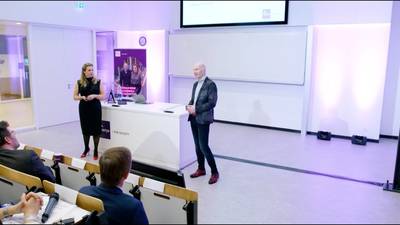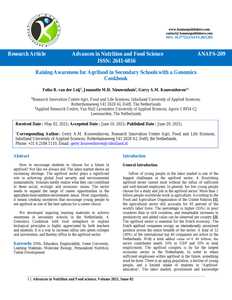Urban communities are particularly vulnerable to the future demand for food, energy and water, and this vulnerability is further exacerbated by the onset of climate change at local. Solutions need to be found in urban spaces. This article based around urban design practice sees urban agriculture as a key facilitator of nexus thinking, needing water and energy to be productive. Working directly with Urban Living Labs, the project team will co-design new food futures through the moveable nexus, a participatory design support platform to mobilize natural and social resources by integrating multi-disciplinary knowledge and technology. The moveable nexus is co-developed incrementally through a series of design workshops moving around living labs with the engagement of stakeholders. The methodology and the platform will be shared outside the teams so that the knowledge can be mobilized locally and globally.
DOCUMENT
Lebanon’s economic crisis has disrupted the country’s energy and water sectors, highlighting their interdependence. The methodologyinvolves surveying 150 municipalities across all Lebanese governorates, ensuring a comprehensive coverage of public and private waterresources. Data on water and energy were collected before and during the crisis to explore this nexus during periods of economic turmoil.The findings reveal a decline in water provision during the crisis, with the average weekly water supply plummeting from 49 h in 2019 to 22 hin 2023. Concurrently, the use of water tankers has surged from 26 to 44%, indicating a concerning shift in water acquisition methods.Despite the crisis, conventional water sources remain predominant, while unconventional sources account for less than 1% of the totalsupply. In response to the energy shortage, renewable energy sources have gained traction in residential, commercial, and industrial sectors.The scarcity and rising cost of electricity have driven the adoption of solar photovoltaics in the water sector, reaching 4.8% for extraction fromunderground reservoirs and 2.8% for distribution. Similarly, the use of solar water heaters has increased from 7.9 to 15.4% in 2023. Thesefindings underscore the interplay between energy and water security during periods of economic instability.
DOCUMENT
Dit rapport, geschreven door de Nederlandse IPBES-auteurs die direct betrokken waren bij beide rapporten, bespreekt de kerninzichten uit de twee recent verschenen IPBES-rapporten: de Transformative Change Assessment en de Nexus Assessment, en past deze toe op de Nederlandse praktijk. Beide IPBES-rapporten benadrukken dat biodiversiteit onmisbaar is voor menselijke bestaanszekerheid, maar dat deze wereldwijd snel achteruitgaat. Het Transformative Change-rapport wijst drie diepere oorzaken van biodiversiteitsverlies aan: het dominante mens-natuur wereldbeeld, groeiende ongelijkheid, en kortetermijnbelangen. Werkelijke verandering vraagt daarom om verschuivingen in waarden, instituties en praktijken, inclusief alternatieve economische modellen en rechtvaardige bestuursvormen. Het Nexus-rapport laat zien dat biodiversiteit, klimaat, water, voedsel en gezondheid nauw verweven zijn. Sectoraal beleid leidt vaak tot ongewenste neveneffecten, terwijl geïntegreerde oplossingen juist brede synergieën opleveren. Het rapport presenteert 71 concrete opties, variërend van natuurherstel en duurzame voedseltransitie tot stedelijke vergroening, duurzame gezondheidszorg en versterking van landrechten. Voor Nederland zijn deze bevindingen urgent. Voorbeelden zoals de Marker Wadden, het Midden-Delfland model en Markemodel en stedelijke vergroening tonen dat systeemtransities haalbaar zijn. Het artikel benadrukt dat gedeelde waarden (zoals rechtvaardigheid, verbondenheid en zorg voor natuur) een fundament vormen om polarisatie te overstijgen en samen te werken aan brede welvaart. Conclusie: Nederland moet de IPBES-aanbevelingen versneld omzetten in integraal beleid om de noodzakelijke systeemtransities te versnellen, waarin natuur, klimaat, landbouw, energie, economie, gezondheid en sociale rechtvaardigheid onlosmakelijk met elkaar verbonden zijn.
DOCUMENT
This essay is a contribution to the research project ‘From Prevention to Resilience’ funded by ZonMw. Motivated by the Covid-19 pandemic, this research project explored how public space and forms of civic engagement can contribute to working towards more resilient urban neighborhoods. The project engaged a community of practice (CoP) to inform the research and to disseminate and critically discuss research outcomes. This essay, and the bundle it is part of, is the outcome of one of these engagements. The authors of this specific essay were asked to offer their disciplinary perspective on a first version of the Human / Non-Human Public Spaces design perspective, at that time still titled Nexus Framework on Neighborhood Resilience (click here and a PDF of this version will be downloaded). The authors were asked to do so based on their field of expertise, being climate-resilient cities. The authors have written this essay in coordination with the research team. To grasp the content of this essay and to take lessons from it, we encourage readers to first get familiar with the first version of the design perspective.
MULTIFILE

Balancing processes of external contingency and internal P-O fit is amongst the challenges facing innovative HE institutions today. This multi-level case study presents findings from a research & development program targeted to investigate and improve organisational-, leadership- and employees’ capacities to design, select and develop the human capital necessary to meet the strategic demands. The R&D project is framed as a collective organisational learning strategy with continuous alternation of research, design, pilots and implementation activities. Work in progress till 2020. At present 25 strategic personnel plans are developed for degree programs and other organizational units, each of which is tailored to the strategic horizon and market of that specific organisational entity. Furthermore, instrumentation to run a strategic personnel planning process for knowledge institutions is developed transferable to other institutions. Finally, input is provided for the development of strategic HRM for career development & mobility, professionalisation, team development and resourcing strategy. https://www.hec2019.nl/108493/wiki/449361/programme-abstracts
DOCUMENT

Op 22 februari 2022 spraken dr. Anne Loonen en dr. Joost Schoeber hun lectorale rede uit, tijdens een bijeenkomst in gebouw Nexus van Fontys Hogescholen op de campus van de TU/e Eindhoven. Daarin spraken ook dr. Jan Bernards, lector Thin Films & Functional Materials bij het lectoraat Applied Natural Sciences), dr. Adriaan van den Brule (Jeroen Boschziekenhuis), dr. ir. Ivo Roessink (Wageningen University and Research) en prof. dr. Maarten Merkx (TU/e).
YOUTUBE

Scientific research from within and beyond academia continues to provide the justification and the knowledge for policy developments directed toward migration and integration governance. A proliferation of scholarship aims to study, pilot, and investigate the ‘best practices’ for facilitating integration, which is then taken up in advice to policy makers. Many authors have written about this science-policy nexus (Boswell 2009; Penninx, Garcés-Mascareñas, and Scholten 2005; Scholten et al. 2015; Verbeek, Entzinger, and Scholten 2015) These works have also engaged in critical reflection, problematizing this nexus and demonstrating how funding structures draw researchers not only into addressing short-term policy goals, but also into reproducing some of the essentialist worldviews that come with methodological nationalism (Wimmer and Glick Schiller 2002) and the ‘national order of things’ (Malkki 1995). Yet, the colonial legacies and dis/continuities of these logics in integrationism have not received much attention so far.The paper takes a critical lens on the implications of the science-policy complicity in reproducing colonial logics of ‘cultural distance’, based on perspectives and empirical research from different national (Netherlands and Switzerland) and supra-national (EU) contexts. We analyse texts which shape the civic integration programme in the Netherlands, the genealogy of the integration requirement to respect the values of the constitution in Switzerland, and the EU framework on migrant integration. This combined analysis brings forth the role scientists and knowledge producers play in (re)producing the colonial logics within integrationism, and their contributions to the regime of truth within which integration discourse operates. Throughout this article, we draw on examples from these different contexts to display that integration and its migranticized (Dahinden 2016) subjects are constructed through practices deemed as scientific or objective expertise, building on important work by Schinkel (2018) on integration research as “neocolonial knowledge production” and Favell’s (2022) critical reflections on integration indicator frameworks. As we demonstrate, the “idea of integration as an issue of cultural distance is rendered imaginable in and through colonial legacies and scientific practices from which policy draws legitimacy. We show how cultural distance is produced in the scientification of migrants’ assimilability in a ‘Western work ethic’, in measurement of migrants’ adherence to liberal values, and through constructions of integration drawing on social imaginaries of national and European identity. Importantly, we argue that by presenting this cultural distance as a product of objective, scientific processes of empirical observation, the notion of cultural distance is normalised and depoliticized, which ultimately legitimizes integrationism as a mode of governance.The present study builds on important contributions (by Schinkel 2017; Favell 2022; Korteweg 2017; Bonjour and Duyvendak 2017, and others) in attempting to destabilize the normalization of integrationism as the widely accepted mode of governance of ‘immigrant’ or ‘ethnic’ populations and their inherent and problematic ‘distance’. The content and structure of this summer school in post-colonial Amsterdam would allow us to continue our critical reflexive discussions to better understand the colonial logics at play and how they operate in multiple contexts and at multiple levels of governance, in and beyond integration
LINK
We summarize what we assess as the past year's most important findings within climate change research: limits to adaptation, vulnerability hotspots, new threats coming from the climate–health nexus, climate (im)mobility and security, sustainable practices for land use and finance, losses and damages, inclusive societal climate decisions and ways to overcome structural barriers to accelerate mitigation and limit global warming to below 2°C.
MULTIFILE

How to encourage students to choose for a future in agrifood? Not like we always did. The labor market shows an increasing shortage. The agrifood sector plays a significant role in achieving global food security and environmental sustainability. Scholars hardly realize what they can contribute to these social, ecologic and economic issues. The sector needs to expand the range of career opportunities in the agriculture-food-nutrition-environment nexus. Most importantly, it means creating incentives that encourage young people to see agrifood as one of the best options for a career choice. We developed inspiring learning materials to achieve awareness in secondary schools in the Netherlands. A Genomics Cookbook with food metaphors to explain biological principles is highly appreciated by both teachers and students. It is a way to increase influx into green colleges and universities, and thereby efflux to the agrifood sector.
MULTIFILE

The importance of water and energy accessibility and use has become more important as new insight into their role for sustainable development goals has become mainstream. The inclusion of water and energy in strategic decision-making is thus key. Supply chain network design (SCND) in the food industry is an interesting case study for the incorporation of water and energy utilization during the design process of global production systems. In the current green SCND research, frequently, single indicators are used such as carbon emissions to measure environmental impact. This paper presents a case study applied to an orange juice supply chain, formulated as a multi-objective optimization model. A single environmental impact indicator optimization approach is paired against one that includes water and energy use explicitly in the objective function set. Mixed conclusions are shown from the results pairing the two strategies side by side.
DOCUMENT